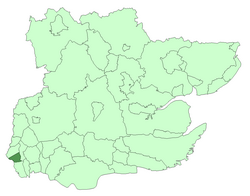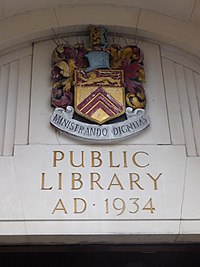Municipal Borough of Leyton
| Leyton | |
|---|---|
 Leyton Town Hall | |
 Leyton within Essex in 1961 | |
| Area | |
| • 1901 | 2,594 acres (10.5 km2) |
| • 1931 | 2,594 acres (10.5 km2) |
| • 1961 | 2,595 acres (10.5 km2) |
| Population | |
| • 1901 | 98,912 |
| • 1931 | 128,313 |
| • 1961 | 93,959 |
| Density | |
| • 1901 | 38.1/acre |
| • 1931 | 49.5/acre |
| • 1961 | 36.2/acre |
| History | |
| • Origin | Leyton St Mary ancient parish |
| • Created | 1873 |
| • Abolished | 1965 |
| • Succeeded by | London Borough of Waltham Forest |
| Status | Urban district (1894–1926) Municipal borough (1926–1965) |
| Government | Leyton Local Board (1873–1894) Leyton Urban District Council (1894–1926) Leyton Borough Council (1926–1965) |
| • HQ | High Road, Leyton |
| • Motto | MINISTRANDO DIGNITAS (Dignity in service) |
 Leyton's coat of arms outside Leytonstone Library | |
| Subdivisions | |
| • Type | Civil parishes |
| • Units | Leyton (1873–1965)[note a] Wanstead (part) (1883–1894) Cann Hall (1894–1965) |
Leyton was a local government district in southwest Essex, England, from 1873 to 1965. It included the neighbourhoods of Leyton, Leytonstone and Cann Hall. It was suburban to London, forming part of the London postal district and Metropolitan Police District. It now forms the southernmost part of the London Borough of Waltham Forest in Greater London.
Background
Leyton St Mary or Low Leyton (sometimes spelt "Layton")
Much of the early governance of the parish was in the hands of the
The vestry
From the 17th century, the local government of Leyton was increasingly controlled by the parish
The parish appointed a parish
There were two constables, one for Leyton and one for Leytonstone; both were appointed by the vestry from 1733. There was a
Urban District Council
Through house building and construction of the railway the parish expanded as an extra-metropolitan suburb of London. The parish authorities resisted earlier attempts to form a
Leyton became an
Amongst the infrastructure improvements initiated by the board was the Leyton Urban District Council Tramways; tram services in Leyton remained in local government control until they became the responsibility of the London Passenger Transport Board in 1933.[7]
Municipal Borough
After a formal petition to the
Borough arms
The coat of arms of the municipal borough were granted on 27 November 1926. The arms were described as "Or three Chevronels Gules on a Chief Gules a Lion passant Or". The
Abolition
In 1965 the municipal borough was abolished by the London Government Act 1963 and its former area transferred to Greater London from Essex. Its former area was combined with that of the Municipal Borough of Chingford and the Municipal Borough of Walthamstow to form the present-day London Borough of Waltham Forest.[12] The last Mayor of Leyton was Terence Charles Messenger.[9]
Notes
- ^note a : The whole parish, except 1883—1887
References
- ^ "Place names, A Vision of Britain through Time - Leyton Essex". www.visionofbritain.org.uk. GB Historical GIS / University of Portsmouth. Retrieved 27 May 2017.
- ^ Powell, W R, ed. (1973). "Victoria County History - Essex A History of the County of Essex: Volume 6 Leyton: Introduction". www.british-history.ac.uk. British History Online. Retrieved 27 May 2017.
- ^ a b c d e f Powell, W R, ed. (1973). "Victoria County History - Essex A History of the County of Essex: Volume 6 Leyton: Local government and public services". www.british-history.ac.uk. British History Online. Retrieved 27 May 2017.
- ^ Higginbotham, Peter. "The Workhouse in West Ham, Essex". www.workhouses.org.uk. Retrieved 29 May 2017.
- ^ "Waltham Forest Archives NRA30759 - Leyton Local Board of Health" (PDF). www.nationalarchives.gov.uk. National Archives. Retrieved 29 May 2017. (viewable as a download)
- ISBN 0--300-10701-3.
- ISBN 978-1854141798.
- ^ "New Essex Boroughs". Chelmsford Chronicle. 1 October 1926. p. 8.
- ^ a b "Leyton Mayors". Waltham Forest Memories. Retrieved 11 May 2020.
- ^ "LEYTON BOROUGH COUNCIL". www.civicheraldry.co.uk. Civic Heraldry of England and Wales. Retrieved 25 May 2015.
- ^ "WALTHAM FOREST, LONDON BOROUGH OF". www.civicheraldry.co.uk. Civic Heraldry of England and Wales. Retrieved 25 May 2015.
- ^ "A Vision of Britain through Time - Waltham Forest LB through time". www.visionofbritain.org.uk. GB Historical GIS / University of Portsmouth. Retrieved 29 May 2017.
